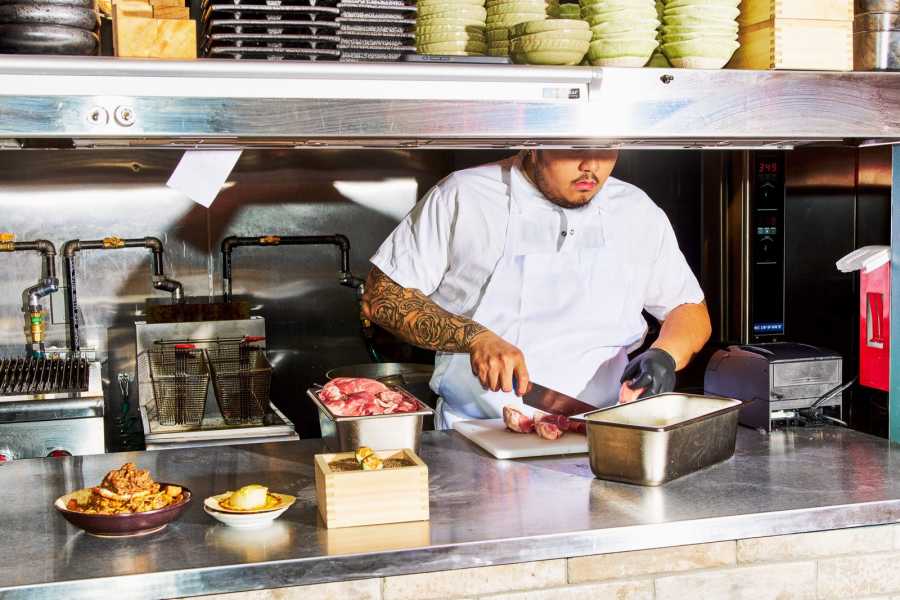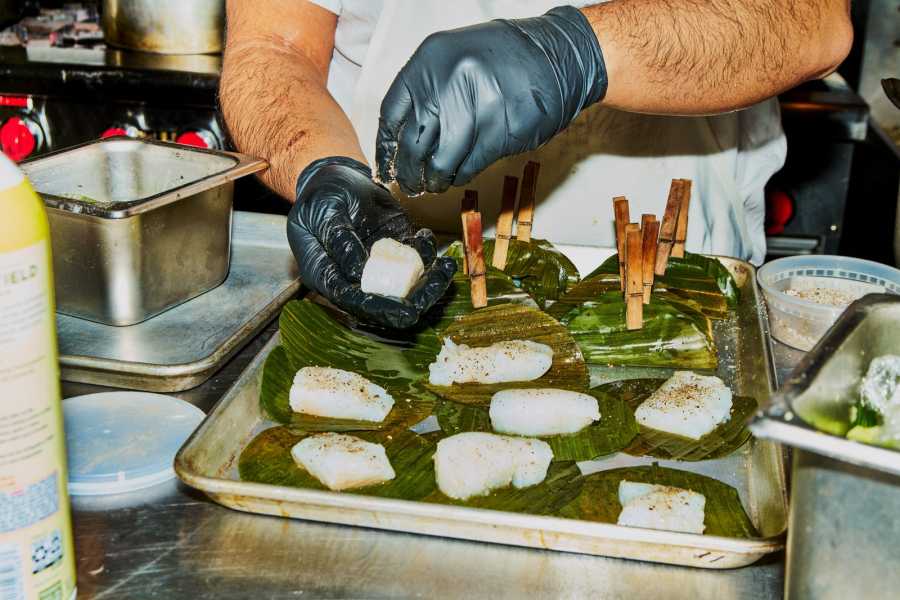
Save this storySave this storySave this storySave this storyYou’re reading the Food Scene newsletter, Helen Rosner’s guide to what, where, and how to eat. Sign up to receive it in your in-box.
Soon after you settle in at your table for the prix-fixe kamayan at Naks, a new restaurant in the East Village, a smiling server will arrive and ask you to get back up again. Kamayan—the word is Tagalog for “by hand”—is a Filipino feast eaten without utensils; with this in mind, Naks is (cleverly, thoughtfully, perhaps beautifully) outfitted with a sink, situated in a discreet corner of the room, to which all diners are led before commencing their meals. It’s a practical step, before such a hands-on meal, and in the restaurant’s warm, wood-wrapped space it takes on a beat of ritualistic intimacy. The tables are laid with banana leaves, and the room is fragranced with their vanilla sweetness. The kamayan at Naks is a collective experience—everyone in the room is served the same course at the same time—and, as diners trickle in, the sense of expectation rises. A server calls for the group’s attention, welcomes everyone to the restaurant, and kicks off the show: “I’d like to introduce you all to Chef Eric.”
Naks
201 First Ave.
(Kamayan $135; à la carte $15-$47.)
Eric Valdez, the executive chef and co-owner of Naks, was born in the Filipino city of Makati. Before opening Naks, he spent two years as the chef de cuisine at the marvellous Dhamaka, on the Lower East Side, where he oversaw the creation of some of New York’s most thrilling Indian dishes. Unapologetic Foods, the restaurant group behind Dhamaka (and the similarly blockbuster restaurants Adda and Semma), is Valdez’s partner in Naks, and the team has made clear that its goal is to provide the same sort of exuberant corrective to New York’s understanding of the food of the Philippines which its other establishments have done for South Asian cooking. The city is not short on Filipino restaurants; Naks, in fact, took over the former address of Jeepney, a pioneer of hip Filipino dining that closed in 2021. But most New Yorkers’ familiarity with the cuisine tends to be limited to dishes such as lumpia (fresh or fried spring rolls), adobo (meat cooked in a vinegary marinade), and the fast-food fried chicken served at Jollibee. Many of the city’s best Filipino restaurants offer kamayan, which is generally something like a barbecue sampler platter. At Naks, it’s a coursed-out tasting menu that aims to offer a tour of Filipino regional cooking, reflecting the melding of native foodways with centuries of Spanish, Chinese, Indian, and American influences, and linking the cuisine to Valdez’s own biography and memories.

Naks’s tasting menu offers a gastronomic tour of the Philippines framed by the personal memories of the restaurant’s chef, Eric Valdez.
Valdez is tattooed, soft-spoken, and a little bit awkward. He’s a cook, and a superb one, but he’s not a performer, and, after that brief introduction to the assembled diners at the beginning of the kamayan, he slips back into the kitchen. On my visit, what followed Valdez’s greeting felt surprisingly like a work in progress. The meal’s dozen-plus courses were consistently delightful. Tiny bites of kinilaw na bat (sea-cucumber ceviche) were neon-bright with calamansi and ginger. A scallop rested on its shell, draped in an ultra-rich emulsion of margarine (a staple in the Filipino pantry) and Eden cheese (a Velveeta-like processed dairy product from the Philippines)—a witty, twisty reimagination of coquilles St. Jacques. The climax of the menu is a gorgeous mess of pancit batil patong (egg noodles with beef and beef liver), turned out on a banana-leaf plate and tossed with a yolky fried egg, followed by a glistening hunk of lechon liempo (roasted pork belly, rolled up around lemongrass and herbs), served with bitter-gourd salad and a small earthenware pot of colorful, gorgeously sharp-tasting vegetable stew.

The climax of the meal is a gorgeous mess of pancit batil patong, egg noodles with beef and liver.

Kinilaw na bat, or sea-cucumber ceviche.
But the joyousness and sense of humor in the food felt at odds with the pageantry surrounding it. After Valdez’s return to the kitchen, each course was announced to the room by one of a rotating Greek chorus of servers, who recounted the absent chef’s own memories (“Our next dish reminds Chef of how naughty he used to be as a child”), often in stilted or superficial ways. (For a skewer of chicken skin cooked over charcoal: “Grilled food always reminds Chef Eric of summertime.”) After each announcement, a pause hung in the room—should we applaud?—as runners brought out the courses in question. Service captains circulated to add final flourishes like a shaving of asín tibuok, a rare salt made by filtering seawater through ashes, over duck stock served in eggshells, a broth-only riff on balut, the famous Filipino dish of cooked fertilized egg. They offered suggestions for the most efficient way to eat each course sans utensils: a slurp, a scoop-and-suck, a three-finger pinch with an assist from the thumb. It was engaging, lively, and fun—kamayan is a meal that wants to be fun—but every time the energy started to grow, and the mood began to coalesce, another classroom-style call for attention would ring out from the service end of the room, and everything would get a little bit weird again.

Banana leaves are a key element of Filipino cuisine; at Naks, they’re used throughout the meal.
A far chiller and more seamless experience is available in the restaurant’s front room, through which one passes to get to the kamayan sanctuary in the back. Here, an à-la-carte menu, closely packed tables, and a cheerful L-shaped bar lend the proceedings a freewheeling friendliness. “Oh, my God, that looks fantastic,” a woman at the table next to mine said, on one visit, leaning forward to get a better look at a platter of wenge-dark fried duck that had just been placed before me. I told her that it was, in fact, fantastic—is anything in the world better than fried duck? The one at Naks nails the whole crispy-melty ecstasy of the dish perfectly. She pointed back at her own table. “Did you get the soup?”
Helen, Help Me!
E-mail your questions about dining, eating, and anything food-related, and Helen may respond in a future newsletter.
Of course I got the soup. Plenty of ink has already been spilled over the titillating Soup No. 5, a small tureen of thick brown broth, heavily spiced with sibot (a smoky-tangy blend of Chinese herbs), in which float bits of bull testicles and penis. A bowl is salty and savory, warming and rich; the soup is traditionally consumed as a hangover cure, perhaps owing to the virility of its star ingredients. (One is spongy, the other chewy; I won’t spoil which is which.) I’m not sure if I’d order it on a return visit, though—I’ll save room, instead, for grilled morsels of pork jowl brushed with glossy-sweet barbecue sauce made with banana ketchup, or sticky skewers of eel glazed in lemon-lime soda and ginger. The K.F.C. (Kanto fried chicken), little popcorn nuggets of tender dark meat, arrives with a bowl of dipping sauce that’s so fiery hot, so puckery with fish sauce, that it made me feel wildly alive. Insistent, punchy flavors like these feel of a piece with the other restaurants under the Unapologetic Foods umbrella, and they support the same thesis. But Valdez also knows how and when to pull back and exert pointed restraint. “This is so good,” the woman next to me cried, taking a bite of an egg-yolk and caramel flan, wobbly and divine. My friend and I, running a few minutes ahead of our neighbor, had just finished luxuriating in the same dessert. “This is so good!” ♦
Sourse: newyorker.com